APPLICATION OF GIS FOR REGIONAL EARTHQUAKE LOSS ESTIMATION
- 格式:pdf
- 大小:34.58 KB
- 文档页数:11

基于ArcGIS的长白山国家级自然保护区的矢量确界引言在我们自己做研究的时候,经常会遇见缺少研究区矢量界线的情况例如自然保护区或一些人为界定的自然区域范围。
当然最好的解决办法是在征求有关管理部门的许可下实地踏查走访,测绘成图,但大多数情况下(如受于当前疫情管控,一些景点限流开放或是不开放)我们并不能去到实地考察,这时我们就要利用网络资源进行一个界线的矢量成图工作(对于网上现有的数据交换和不明来源的数据我们务必要进行检查和修正才能使用)。
以下是笔者在实验中总结的需要注意的问题:①全国地理信息资源目录服务系统提供的1:100万全国基础地理数据库和1:25万全国基础地理数据库可以作为标准数据参考;(/)②涉及国界的问题需要重点关注,国家版图同国旗、国徽、国歌一样,是国家的象征。
熟悉国家版图构成,自觉维护国家领土和主权完整是每个公民的责任和义务。
③要引用合法来源的地图或者使用专业机构编制的地图。
应优选用自然资源部和各地自然资源部门提供的标准地图,保护区官方网站给出的矢量边界图和确界点数据可以作为参考。
④可下载多景研究区范围内的遥感影像作为参考,确定和修正保护区矢量边界。
以下为长白山国家级自然保护区的矢量确界步骤:㈠概述吉林长白山国家级自然保护区位于中华人民共和国吉林省东南部延边朝鲜族自治州安图县,东南部与朝鲜民主主义人民共和国相毗邻。
地理坐标为东经127°42′55″至128°16′48″,北纬41°41′49″至42°25′18″。
全区南北最大长度为80km,东西最宽达42km,总面积196618公顷。
1960年,建立长白山保护区。
1986年,晋升为国家级自然保护区。
属于自然生态系统类别中森林生态系统类型的自然保护区。
㈡前期数据准备①1:100万全国基础地理数据库长白山国家级自然保护区区域范围数据下载,在数据查询界面选中长白山国家级自然保护区所在区域的新图号(K52)并查看数据详情,确认无误后加入成果车,完成用户注册及填写相关信息(务必如实填写)后即可下载数据。
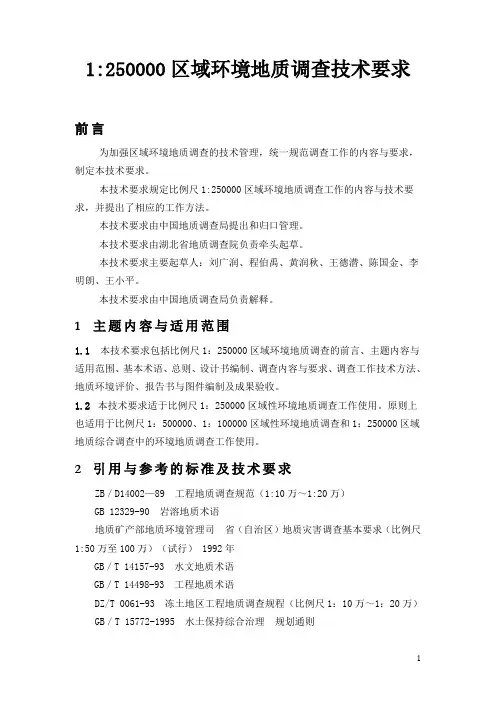
1:250000区域环境地质调查技术要求前言为加强区域环境地质调查的技术管理,统一规范调查工作的内容与要求,制定本技术要求。
本技术要求规定比例尺1:250000区域环境地质调查工作的内容与技术要求,并提出了相应的工作方法。
本技术要求由中国地质调查局提出和归口管理。
本技术要求由湖北省地质调查院负责牵头起草。
本技术要求主要起草人:刘广润、程伯禹、黄润秋、王德潜、陈国金、李明朗、王小平。
本技术要求由中国地质调查局负责解释。
1主题内容与适用范围1.1 本技术要求包括比例尺1:250000区域环境地质调查的前言、主题内容与适用范围、基本术语、总则、设计书编制、调查内容与要求、调查工作技术方法、地质环境评价、报告书与图件编制及成果验收。
1.2本技术要求适于比例尺1:250000区域性环境地质调查工作使用。
原则上也适用于比例尺1:500000、1:100000区域性环境地质调查和1:250000区域地质综合调查中的环境地质调查工作使用。
2引用与参考的标准及技术要求ZB/D14002—89 工程地质调查规范(1:10万~1:20万)GB 12329-90 岩溶地质术语地质矿产部地质环境管理司省(自治区)地质灾害调查基本要求(比例尺1:50万至100万)(试行) 1992年GB/T 14157-93 水文地质术语GB/T 14498-93 工程地质术语DZ/T 0061-93 冻土地区工程地质调查规程(比例尺1:10万~1:20万)GB/T 15772-1995 水土保持综合治理规划通则地质矿产部地质环境管理司省(自治区)环境地质调查基本要求(比例尺1:50万)(试行) 1996年SL 190-96 土壤侵蚀分类分级标准DZ/T 0190-1997 区域环境地质勘查遥感技术规程比例尺1:50000TB 10055-98 铁路工程地质黄土地区勘测规则国土资源部地质环境司县(市)地质灾害调查与区划基本要求 2000年中国地质调查局 1:250000区域地质调查技术要求(暂行) 2001年GB 50021-2001 岩土工程勘察规范GB 50324-2001 冻土工程地质勘察规范3基本术语地质环境 geologic environment是人类自然环境的一部份,系指与人类生活与生产活动有相互影响的地质体及地质作用的总和。

国家高技术研究发展计划(863计划)地球观测与导航技术领域“全球陆表特征参量产品生成与应用研究”重点项目申请指南一、指南说明在目前的全球变化研究与地球系统模型研发中,卫星观测没有发挥其全部潜力,迄今为止,针对全球陆面变化研究与陆面模型研发,国际陆地遥感领域仍缺乏长时间序列、高时空分辨率和高质量的全球陆表特征参量产品。
我国的地球系统模型研发与全球变化研究已面临着重要的发展机遇期,非常有必要集中力量,建立全球陆表特征参量产品生产系统,支持全球变化研究与新一代地球系统模型的研发。
本重点项目将面向全球陆面变化与陆面模型研发,综合利用国内外卫星遥感数据源,发展全球陆表特征参量产品生成的新技术和新方法,生产长时间序列、高时空分辨率和高质量的全球陆表特征参量产品集,进而改进关键陆面过程的参数化方案及数据同化技术,提高陆面模型的模拟能力,开展全球陆表变化示范研究。
本项目注重产学研相结合,鼓励国内优势单位联合承担,鼓励承担单位配套支持。
本指南公开发布,将通过择优方式选择其中一家单位作为项目的牵头单位。
二、指南内容1、项目名称全球陆表特征参量产品生成与应用研究2、项目总体目标综合利用国内外卫星遥感数据源,发展全球长时间序列陆表特征参数产品生成的关键技术,研发全球陆表特征参量产品生成系统;生成全球长时间序列的高精度叶面积指数、地表反照率、发射率、下行短波辐射、下行有效光合辐射等陆表特征参量遥感产品;进而改进关键陆面过程的参数化方案及同化技术,提高其模拟能力,开展全球陆表变化应用示范研究,为我国应对全球变化决策提供数据基础与技术支撑。
3、项目主要研究内容(1)全球陆表特征参量数据库建设:面向全球变化与陆面模型的需求,研究全球陆表特征参量遥感产品生产体系;研究全球多源对地观测数据预处理与关联整合技术,全球陆表特征参量产品集入库、共享与发布技术;综合集成国内外多源卫星遥感数据及陆表特征参量产品,建立全球陆表遥感数据与陆表特征参量产品数据库。

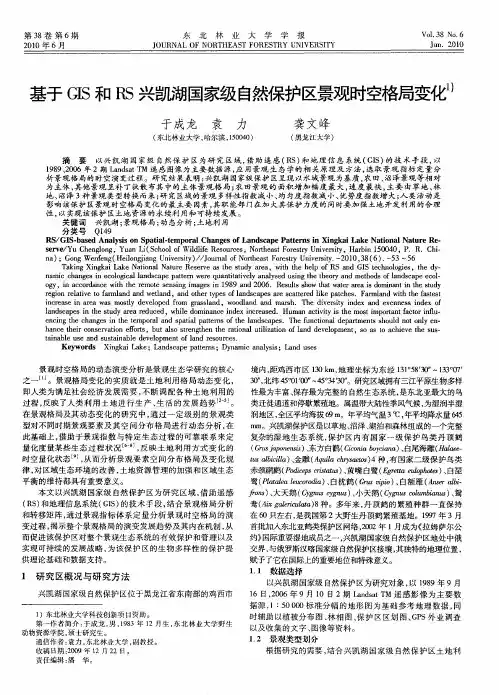
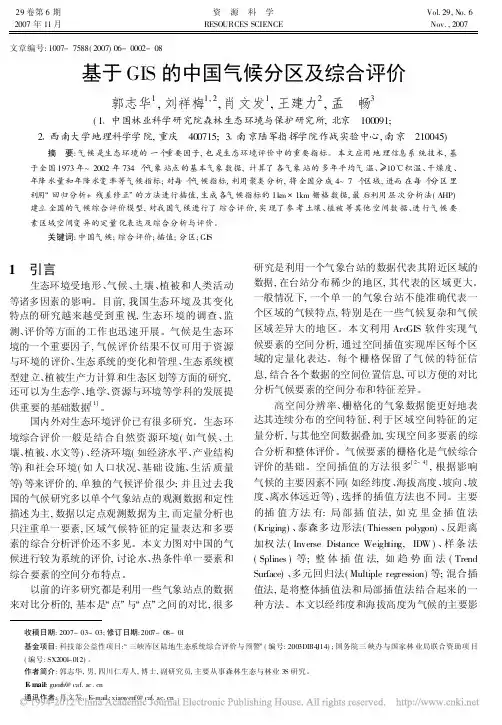
29卷第6期2007年11月资 源 科 学RESOURCES SCIENCE Vol.29,No.6Nov.,2007文章编号:1007-7588(2007)06-0002-08收稿日期:2007-03-03;修订日期:2007-08-01基金项目:科技部公益性项目:/三峡库区陆地生态系统综合评价与预警0(编号:2003DIB4J14);国务院三峡办与国家林业局联合资助项目(编号:SX2001-012)。
作者简介:郭志华,男,四川仁寿人,博士,副研究员,主要从事森林生态与林业3S 研究。
E -mail :guoz h@通讯作者:肖文发,E -mail:xiaowenf@基于GIS 的中国气候分区及综合评价郭志华1,刘祥梅1,2,肖文发1,王建力2,孟 畅3(11中国林业科学研究院森林生态环境与保护研究所,北京 100091;21西南大学地理科学学院,重庆 400715;31南京陆军指挥学院作战实验中心,南京 210045)摘 要:气候是生态环境的一个重要因子,也是生态环境评价中的重要指标。
本文应用地理信息系统技术,基于全国1973年~2002年734个气象站点的基本气象数据,计算了各气象站的多年平均气温、\10e 积温、干燥度、年降水量和年降水变率等气候指标;对每个气候指标,利用聚类分析,将全国分成4~7个区域,进而在每个分区里利用/回归分析+残差修正0的方法进行插值,生成各气候指标的1k m @1km 栅格数据,最后利用层次分析法(AHP)建立全国的气候综合评价模型,对我国气候进行了综合评价,实现了参考土壤、植被等其他空间数据、进行气候要素区域空间变异的定量化表达及综合分析与评价。
关键词:中国气候;综合评价;插值;分区;GIS1 引言生态环境受地形、气候、土壤、植被和人类活动等诸多因素的影响。
目前,我国生态环境及其变化特点的研究越来越受到重视,生态环境的调查、监测、评价等方面的工作也迅速开展。

使用遥感与GIS进行自然保护区规划的方法遥感和地理信息系统(GIS)是现代科技中应用广泛的工具,可以在自然保护区规划中起到很大的作用。
本文将探讨使用遥感与GIS进行自然保护区规划的方法,并介绍其在不同层面上的应用。
首先,遥感技术可以提供大范围、高分辨率的地表信息,对自然保护区的边界确定至关重要。
通过卫星或无人机获取的高清图像可以帮助我们了解保护区的地貌、植被分布等信息,从而更准确地划定保护区边界。
此外,遥感技术还能提供多时相的图像数据,使我们能够观测到自然保护区内植被和水体的动态变化。
这些数据可以帮助我们预测保护区未来可能面临的挑战,为规划和管理提供科学依据。
其次,GIS技术能够对保护区内的空间数据进行整合和分析。
通过建立地理数据库,我们可以收集、存储和管理大量的地理信息,包括地形、土壤、水文等数据。
这些数据可以帮助我们更好地理解保护区的生态环境和资源状况。
例如,通过分析地形数据,我们可以确定山脉、河流等地理要素对植物分布和物种迁徙的影响,从而优化保护区内的生态连通性。
此外,GIS还可以进行空间分析,比如通过栅格或矢量数据分析来评估土地利用、植被类别等空间分布的特征,为制定保护区规划提供科学依据。
在自然保护区规划中,遥感与GIS还可以应用于生物多样性评估。
遥感技术能够获取大面积的遥感影像数据,通过遥感图像分类和植被指数等方法,可以衡量保护区内不同植被类型的分布面积和变化趋势,从而评估植物物种的多样性。
此外,GIS还可以结合物种分布数据,利用空间分析方法评估物种的分布范围、优势度、丰度和稳定性等指标,为保护区规划提供保护重点和管理策略的科学依据。
除此之外,遥感与GIS还可应用于自然保护区的生态恢复与监测。
遥感技术能够提供保护区内不同生态系统的时空变化信息,通过获取的多时相影像数据可以观测到植被覆盖变化、湿地退化等情况。
结合GIS技术,我们可以建立监测模型和指标体系,对保护区内植被恢复、水质改善等生态恢复过程进行定量评估。

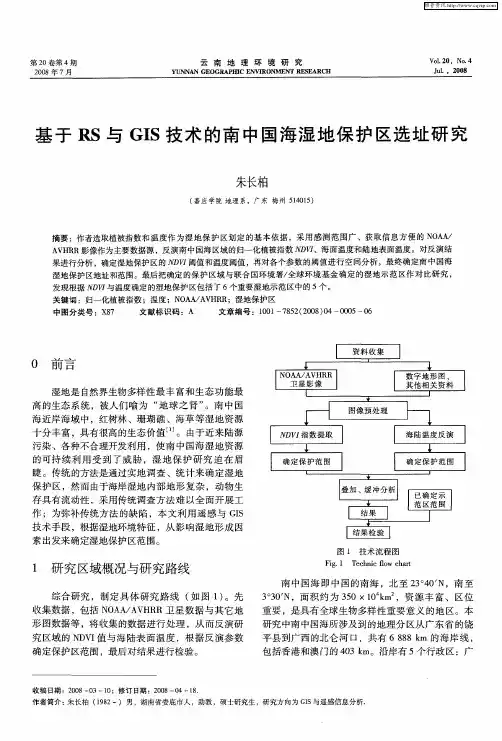
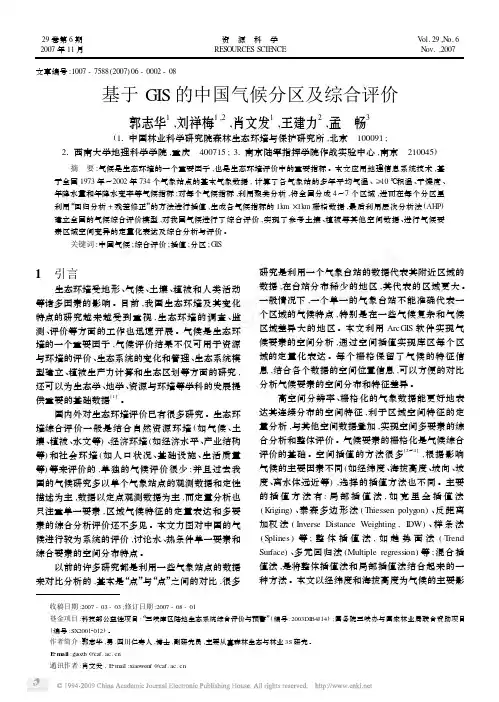
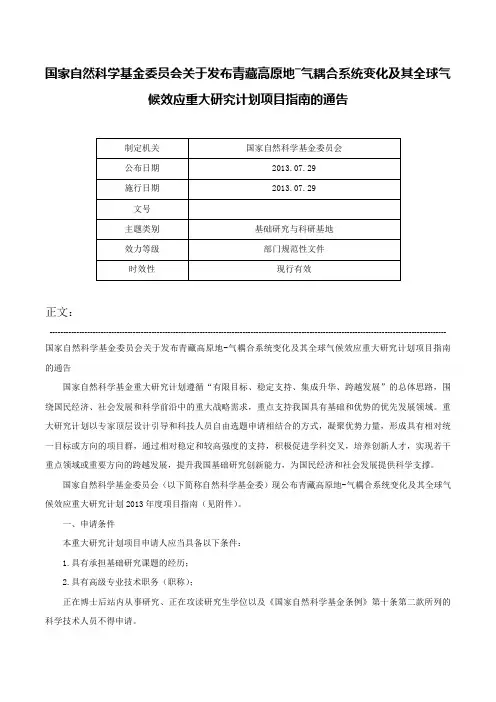
国家自然科学基金委员会关于发布青藏高原地―气耦合系统变化及其全球气候效应重大研究计划项目指南的通告正文:---------------------------------------------------------------------------------------------------------------------------------------------------- 国家自然科学基金委员会关于发布青藏高原地-气耦合系统变化及其全球气候效应重大研究计划项目指南的通告国家自然科学基金重大研究计划遵循“有限目标、稳定支持、集成升华、跨越发展”的总体思路,围绕国民经济、社会发展和科学前沿中的重大战略需求,重点支持我国具有基础和优势的优先发展领域。
重大研究计划以专家顶层设计引导和科技人员自由选题申请相结合的方式,凝聚优势力量,形成具有相对统一目标或方向的项目群,通过相对稳定和较高强度的支持,积极促进学科交叉,培养创新人才,实现若干重点领域或重要方向的跨越发展,提升我国基础研究创新能力,为国民经济和社会发展提供科学支撑。
国家自然科学基金委员会(以下简称自然科学基金委)现公布青藏高原地-气耦合系统变化及其全球气候效应重大研究计划2013年度项目指南(见附件)。
一、申请条件本重大研究计划项目申请人应当具备以下条件:1.具有承担基础研究课题的经历;2.具有高级专业技术职务(职称);正在博士后站内从事研究、正在攻读研究生学位以及《国家自然科学基金条例》第十条第二款所列的科学技术人员不得申请。
二、限项规定1.具有高级专业技术职务(职称)的人员,申请或参与申请本次发布的重大研究计划项目与正在承担(包括负责人和主要参与者)以下类型项目合计限为3项:面上项目、重点项目、重大项目、重大研究计划项目(不包括集成项目和指导专家组调研项目)、联合基金项目(指同一名称联合基金项目)、青年科学基金项目、地区科学基金项目、优秀青年科学基金项目、国家杰出青年科学基金项目(申请时不限项)、国际(地区)合作研究项目(特殊说明的除外)、科学仪器基础研究专款项目、国家重大科研仪器设备研制专项(自由申请项目)、优秀国家重点实验室研究专项项目,以及资助期限超过1年的委主任基金项目和科学部主任基金项目等。
2015年12月中共中央办公厅、国务院办公厅印发的《生态环境损害赔偿制度改革试点方案》开启了我国生态环境损害赔偿制度的序幕。
生态环境损害赔偿制度在美国被称为“自然资源损害赔偿”①制度,两者所指向的对象都是因污染环境、破坏生态造成环境要素和生物要素的不利改变及上述要素构成的生态系统功能的退化。
生态环境损害赔偿不同于传统侵权法意义上的损害赔偿,其必须适用完全赔偿的原则来赔偿受损害物的完整利益,包括物的再生费用和物的非市场价值[1],这里的物就是组成生态环境的各类自然资源。
这些费用的量化必须通过专业的鉴定评估人员,按照特定的技术标准和法定的评估标准及程序,运用科学的方法,对生态环境修复的费用、损害期间生态价值损失的费用进行估算。
我国正在开展的生态环境损害赔偿工作,将推动立法机关建构生态环境损害评估制度。
美国作为较早进行自然资源损害赔偿实践的国家,从联邦政府到部分地方政府都出台了相关立法,在环境联邦主义传统的影响下,地方立法以联邦环境法为准,对联邦法律进行细化和补充。
路易斯安那州根据自身的特点出台了对口法律,构建了一套完整的自然资源损害赔偿制度,其中包括较为完善的自然资源损害鉴定评估体系,值得我们学习借鉴。
1 路易斯安那州自然资源损害评估制度的背景1.1 美国联邦自然资源损害评估制度美国从20世纪70年代开始构建自然资源损害赔偿规则体系,在联邦层面已有《清洁水法》(Clean Water Act)、《综合环境反应、赔偿和责任法》(CERCLA)、《石油污染条例》(Oil Pollution Act Regulations,简称C.F.R.§990②)。
《清洁水法》规定了水污染排放标准和执行、许可证管理、行政监督管理体制、公民诉讼、行政程序等[2],并首次规定了水污染的评估和修复;《综合环境反应、赔偿和责任法》又被称为《超级基金法》(Superfund),主要针对释放危险物质的污染物造成的土地资源损害,建立了比较完善的自然资源损害赔偿制度,规定了评估主体、赔偿范围、评估方法和程序的指导等;《石油污染条例》有专门一个规则,即自然资源损害评估条款。
首届地理设计(GeoDesign)峰会在美南加州召开
马劲武
【期刊名称】《中国园林》
【年(卷),期】2010(026)004
【摘要】@@ 正当北半球大部分地区冰天雪地、寒风凛冽之时,美国南加州却风和日丽、温暖如春.2010年1月6~8日,在位于南加州的环境系统研究院(ESRI)总部红地市(Redlands),召开了世界首届地理设计(GeoDesign)峰会.
【总页数】2页(P17-18)
【作者】马劲武
【作者单位】
【正文语种】中文
【相关文献】
1.群贤毕至齐聚龙城r打造军民融合产业发展新高地r——首届军民融合产业发展高峰论坛r暨中国国防工业企业协会军民融合产业联盟首届年会在太原召开 [J],
2.中美南海北部湾盆地太阳物探协议区技术交流会在湛江召开 [J], 林自强
3.全球气候行动峰会在美国加州召开 [J],
4.第三届国际信息研究峰会暨第四届国际信息哲学研讨会在美国加州伯克利大学召开 [J], 王健
5.美南加州租房买房价格均涨 [J],
因版权原因,仅展示原文概要,查看原文内容请购买。
应用多种遥感影像处理方法提取玛尼7.5级地震中的热红外
异常信息
郭卫英;单新建
【期刊名称】《内陆地震》
【年(卷),期】2005(019)002
【摘要】以1997年11月8日发生在西藏玛尼的MMS7.5地震为例, 应用多种红外遥感影像处理方法, 提取地震发生前后的红外辐射的时空演变信息.结果发现,在震前4天震中所在的玛尔盖茶卡断层以及东昆仑断裂带,出现3-5℃的增温现象,该异常在地震后逐渐消失.
【总页数】7页(P142-148)
【作者】郭卫英;单新建
【作者单位】新疆维吾尔自治区地震局,新疆,乌鲁木齐,830011;中国地震局地质研究所,北京,100029
【正文语种】中文
【中图分类】P315.63
【相关文献】
1.四叉树与多种活动轮廓模型相结合的遥感影像水边线提取方法 [J], 喻金桃;郭海涛;李传广;卢俊;姜春雪
2.基于热红外遥感影像的作物冠层温度提取 [J], 张宏鸣;王佳佳;韩文霆;李书琴;王红艳;付振宇
3.基于热红外遥感数据的尕斯库勒盐湖温度异常信息提取及成因探讨 [J], 王俊虎; 武鼎; 郭帮杰
4.对数泛克立格法在东天山土屋—延东地区Cu、Au异常信息提取中的应用 [J], 熊前进;柴小婷;万翔;金朝;杜翌超;陈曦;胡飞
5.乌鲁木齐台地磁观测资料异常信息提取及应用 [J], 木拉提江·阿不来提;杨福喜;张青远;毛玉剑
因版权原因,仅展示原文概要,查看原文内容请购买。
遥感地质分析在油气靶区建立中的应用
张海玲;王家林;许惠平
【期刊名称】《上海国土资源》
【年(卷),期】2008(000)002
【摘要】在对松潘-阿坝地区遥感图像解译的基础上,基于GIS对解译出的线性体进行特征分析,并与本区航磁、重力及大地电磁测深资料进行综合分析,从而推断出:根据卫星影像解译出的盆地南部和北部的分界线可能是一条基底断裂,断裂的存在对该地区的油气生成,运移及聚集都可能产生明显的影响.这一推断为在研究区内建立油气勘探区域提供了有力的证据.
【总页数】3页(P57-59)
【作者】张海玲;王家林;许惠平
【作者单位】同济大学海洋地质国家重点实验室,上海,200092;同济大学海洋地质国家重点实验室,上海,200092;同济大学海洋地质国家重点实验室,上海,200092【正文语种】中文
【中图分类】P61
【相关文献】
1.遥感技术预测油气勘探靶区 [J], 黄光玉;王润生;沈占锋;赵欣梅
2.遥感技术预测油气勘探靶区 [J], 黄光玉;沈占锋;王润生
3.遥感技术预测油气勘探靶区 [J], 黄光玉;王润生;沈占锋;赵欣梅
4.遥感技术在某铜多金属找矿靶区预测中的应用 [J], 徐文武;周明
5.遥感技术在某铜多金属找矿靶区预测中的应用 [J], 徐文武; 周明
因版权原因,仅展示原文概要,查看原文内容请购买。
APPLICATION OF GIS FOR REGIONAL EARTHQUAKE LOSS ESTIMATION Regional earthquake loss studies are being performed for several years to assist local and state governments, and emergency response planners in preparing for and mitigating damage from future s eismic events. Earthquake loss studies often include estimates of repair costs, deaths and casualties, functional loss to lifeline systems and emergency response facilities, and regional economic impacts on a short-term and long-term basis. A major limitation of many past regional loss studies is that they are stagnant in the sense that the inventory and geologic data collected, analysis done and the reports produced cannot be updated to reflect changes in the inventory, demographics or economy of the region. One possible reason for this is since the inventory data can not be realistically included in the final reports, updating existing studies without undertaking a major data collection effort is virtually impossible. In addition, the effectiveness of the loss estimation results was limited in the sense that the analysis results have typically been summarized in a report or tabular format, making it cumbersome to quickly identify those geographic areas most likely to experience significant damage.With the development and maturity of GIS technology, many of these limitations have been overcome and dynamic loss studies that present results in a more usable format can now be performed. A recent project, sponsored by the Federal Emergency Management Agency (FEMA) and the National Institute of Building Sciences (NIBS) and awarded to RMS , has resulted in a powerful GIS-based software package for performing regional earthquake loss estimates. The implementation of integrated GIS technology provides an approach which permits rapid evaluation of complex inventory databases under a variety of earthquake scenarios and allows the user to interactively view results almost immediately. The results can be summarized in tables of loss values as well as maps of damage estimates that can be overlaid to easily view which areas are likely to be most severely affected.The power of GIS technology makes creating and modifying maps a very simple task. For application in regional loss estimation, there are a variety of very useful options that are available :• First, inventory collected and input into databasest can be quickly and easily displayed on a map of the region. Using colors and symbols, many different attributes can be highlighted.For example, the number and location of seismically vulnerable structures in your region can easily be presented.• Second, existing maps, such as liquefaction potential maps available from the US Geological Survey, can be digitized and displayed on a map of the region. These can then be overlaid with maps of ground shaking and lifeline systems to qualitatively assess the most vulnerable lifeline components.• Third, using thematic maps of loss estimates, localities with high levels of damage can be quickly identified.• Fourth, the functionality of regional lifeline systems such as water delivery systems can be graphically displayed by mapping the system and using colors to identify those parts of the system most likely to be nonfunctional.GIS technology provides emergency response pl a nners and government officials with a very powerful tool to visualize and understand the impacts of an earthquake on a region. In this paper, a conceptual discussion will be presented on the benefits and application of GIS technology for regional loss estimation. In addition, examples will be used to demonstrate the effectiveness of presenting information through thematic mapping techniques.Geographic Information System (GIS) -- A General DescriptionA modern Geographical Information System is a computer system designed to store, analyze, and display geographic information. The geographic information may be any of an infinite variety of data sets each associated with a spatial coordinate system. The spatial referencing of the information permits the data sets to be linked. This linkage provides a powerful tool for analysis and integration of data sets from many different sources using the same GIS software. An example of various types of geographically linked data sets useful for seismic zonation is shown in Figure 1.Figure 1In general, each GIS is comprised of basic components that permit the input, manipulation, analyses, archival, and output of spatially referenced data. Following is a brief summary of technical aspects of these components and associated analyses functions.Formally defined a GIS is a computer-based system that provides for 1) input, 2) management (data storage and retrieval ), 3) manipulation and analysis, and 4) output of georeferenced data. These basic components of a GIS are illustrated in Figure 2.GIS ComponentsFigure 2 Components of a Geographic Information System (GIS).Data InputThe data input component represents the resources required to convert data from existing formats to the format required for storage and analysis by the computer software and hardware. Original data sources may range from paper maps to tables to digital files, each of which may have its own format. Conversion of these data to the required digital format can be simple and relatively automatic if the original data require only conversion from one digital format to another. In other cases digitalization of maps and assignment of appropriate attributes can require major efforts. Data input is often the most costly and time consuming component of a GIS project and may represent a cost several times that of the hardware and software. However, with the rapid expansion in uses and users, digital GIS data bases are rapidly growing and many of these can be used for a variety of GIS projects. Further with the advent of scanners to create digital images of paper maps the time and cost factors have come down.Data ManagementThe data stored in a GIS is comprised of two sets of information or files. One is a graphic file which specifies the location of points, lines, and polygons and a second file which specifies the characteristics or attributes of the graphic entities. The two files can serve to link and integrate avariety of different types of information to a specific location. When data is input into a GIS it must be ascribed locations via point, line, and area definitions and attributed characteristics via the attribute file. The user can operate on these files independently to retrieve, analyze, and integrate the input data sets.Two types of data structures are in primary use, one is termed raster and the other vector. The raster format consists of a regular grid of square or rectangular cells or pixels defined by row and column locations to which has been ascribed some value of the desired attribute. The vector format specifies the location or position of points, lines, and polygons for the data set of interest with an associated set of attributes for each. With the specification of definitions for arcs, nodes and polygons and topological relations, the vector format provides a powerful tool for rapid manipulation and processing of large data bases but it is complex. The simpler raster format is especially well suited for depicting rapidly varying geographic information and enhancement of digital images used for example in remote sensing and satellite imagery. Most modern GISs use both data structures and include software to convert certain types of data sets from one format to the other.Data Manipulation and AnalysisModern relational data base technology is used to store, retrieve and manipulate the graphic and attribute files of modern GISs. Analysis functions permit the integration and derivation of geographically linked data sets. They allow the overlay, query, and development of new data layers. They permit the use of external function libraries and user specified or programmed function software. Rapid advances in relational data base technology, computational speed and storage capacities of computer hardware, and GIS analysis software have led to dramatic improvements in the capabilities of GISs.Data OutputThe output or display of derived GIS products may occur in a variety of formats, including paper maps, tabular files, CRT screen display, and/or digital computer files. The particular output format specified by the user determines the necessary software functions and hardware needed for each application. Convenient display of products at various stages of development often leads to new spatial insights and improved results. Rapid advances in computer networking and the storage capacity of removable disks have greatly improved capabilities to exchange and integrate GIS data sets from various users.Two most popular GIS systems are Mapinfo and ArcView.Application of GIS to Seismic Risk AssessmentEarthquakes can cause significant damage to both the man made and the natural environments. The impact of these types of events can destroy entire ways of life. In addition to structural damage, seismic events can undermine the infrastructure that is vital to the function and well being of the community, can cause significant monetary losses, casualties and disease and can inflict long-term economic hardship on the local or regional economy. When we talk about the risk of a region to a seismic event, we are talking about the vulnerability of the region to damage, losses and casualties.The magnitude of the damage and losses depend not only on the seismic hazard, but also to a great extent upon the density of the population, the location and type of building exposure, thesocio-economic makeup of the region and their spatial relationship to the hazard. If an earthquake occurs in an sparsely populated region, there will be little to no effect on regional infrastructure and little likel ihood of loss of life. However, if the same earthquake were to occur near a large city, a situation could result in very high losses. Economically challenged regions with inexpensive non-engineered construction are more vulnerable and can expect heavier damage, for example Latur Earthquake in India, than regions that have large numbers of new buildings that are designed and constructed to modern codes. Local economies that are highly dependent on one or two types of businesses or industries that are destroyed by the event, unemployment can be almost complete and recovery very slow.Seismic risk assessment can be defined as a procedure to estimate the damage and losses to a seismic event by combining seismic hazards with the inventories of the built environment. The assessment procedure can be broken down into three simple steps• Quantify the seismic hazards for a given event.As discussed in this paper, seismic hazards can consist of ground shaking demands, spectral response demands, and ground failure f rom liquefaction, landsliding and surface fault ruptures.• Quantify the built environment inventory of the affected region.Once the seismic hazard has been quantified, the next step is to create a spatial representation of the region’s structural, demographic, and economic inventory.Inventories are the most expensive and time consuming part of a seismic risk assessment with the final damage/loss estimates highly dependent on the quality of the inventory data.GIS-based inventory collection systems have the flexibility to permit different levels of detail in inventory collection as dictated by levels of funding. Data can be collected and stored as either site-specific information or can be aggregated on a regional basis and stored with the associated geographical unit.• Combine inventory data with seismic hazards to assess the impacts.The final step involves combining seismic hazard information with spatially distributed inventory data and then applying motion damage relationships to determine damage estimates. This procedure works for regional inventory aggregation models to a comprehensive site-specific analysis of every structure in the region. In addition to building damage, loss of function, casualties, monetary losses, shelter requirements and utility service outages are examples of impacts that can be evaluated using the same process.A GIS-based software system creates the ideal framework to integrate the various components of seismic risk assessment. GIS technology provides a powerful tool for displaying outputs and permits users to "see" the geographical distribution of impacts from different earthquake scenarios and assumptions. The interactive features of a GIS platform can provide an user-oriented environment for entering and accessing data, and allows the user to overlay input and output data on thematically shaded maps of the region. The use of different display colors permits rapid visual identification of areas with the potential for high damage and loss (i.e., areas that have both significant ground shaking and a large number of vulnerable buildings).While GIS technology is optimal for spatial reasoning (interpretation of data in a spatial context), and for providing an intuitive graphical input/output mechanism to the user, it is a cumbersomeenvironment for the execution of complex numerical algorithms. Alternatively, programming languages, such as C++, can be applied to encode otherwise complex algorithmic and rule-based relationships.Rather than accept the constraints associated wi t h the different software environments, the current trend in software development is to create a system which integrates each of the software strategies. To the user, the resulting system can have the look and feel of a GIS-based program. However, embedded within the GIS are the RDBMS technologies, C++ support libraries necessary to support the database management and computational requirements of a regional risk assessment. Such a system is often referred to as integrated geographical information system (IGIS).The major problems with the non GIS based frameworks are :• The inability of a single study to meet the very different needs of users at different levels of government• The costs of collecting inventory and performing the studies• The stagnant nature of the results when they are in a report form, and the technical nature in which results have been presented.• The final reports rarely contain any documentation of the inventory used, and the output often provided in a tabular format that provided little insight about the geographical distribution of the damage and losses.The use of a GIS-based risk assessment model will overcome many of the problems identified above. Based on the resources and level of funding models can be developed which perform simplified estimates of damage and loss using limited inventory collected on a modest budget. The models can be easily modified to allow for more precise estimates with are based on extensive inventory collected at a large cost to the communityThe GIS envi ronment also accommodates the needs of a wide spectrum of potential users. The modular framework inherent to a GIS allows the user to activate or deactivate models on command. The framing of risk assessment methodology as a collection of models also permits the addition of new available state-of-the-art models (or modify models for local or regional needs) without reworking the entire methodology. This approach permits a logical evolution of the methodology as research progresses and the state-of-the-art advances. It will also facilitate rapid transfer of information between the academic/ research community and the practitioner.Results from the GIS-based analyses are not stagnant and can to be updated as the inventory is improved, the building stock or the demographics of a region change, models change or if revised seismic hazards are quantified. Once the inventory data is input in the GIS program, information can be readily updated and any number of hazard scenarios can quickly be evaluated. An advantage of the GIS technology is that once the inventory database is built, it can be used for other purposes such as city planning, public works or emergency preparedness for other types of natural disasters.Current Application of GIS to Seismic Risk AnalysisThe National Institute of Building Science (NIBS), under a cooperative agreement with FEMA, and in collaboration with RMS has developed a nationally applicable standardized methodology for assessment of potential losses from natural hazards. The first phase of this project was to develop guidelines and procedures for making earthquake loss estimates at the regional or local scale. These loss estimates can be used by local, state and regional officials to plan and stimulate efforts to reduce risks from earthquakes and to prepare for emergency response and recovery. A secondary purpose of this project is to provide FEMA with a basis for assessing nationwide risk of earthquake losses. The methodology was recently completed and is now undergoing testing through two pilot studiesStandardized earthquake loss estimation methodology:The earthquake loss estimation methodology will provide local, state and regional officials with the tools necessary to plan and stimulate efforts to reduce risk from earthquakes and to prepare for emergency response and recovery from an earthquake. The methodology will also provide the basis for assessment of nationwide risks of earthquake loss.The methodology can be used by a variety of users with needs ranging from crude estimates that require minimal input to refined calculations of earthquake loss. The methodology may be implemented using either integrated geographical information system (GIS) technology provided in a software package or by application of the theory documented in a Technical Manual. Implementation of the methodology by either technical or non-technical users will be guided by an easily understood Applications Manual.The vision of earthquake loss estimation requires a methodology that is both flexible, accommodating the needs of a variety of different users and applications, and able to provide the uniformity of a standardized approach. The framework of the methodology includes each of the components shown in Figure 2-1: Potential Earth Science Hazard (PESH), Inventory, Direct Physical Damage, Induced Physical Damage, Direct Economic/Social Loss and Indirect Economic Loss. As indicated by arrows in the figure, modules are interdependent with output of some modules acting as input to others. In general, each of the components will be required for loss estimation. However, the degree of sophistication and associated cost will vary greatly by user and application. It is therefore necessary and appropriate that components have multiple levels (multiple modules) of detail or precision when such is required to accommodate user needs. Framing the earthquake loss estimation methodology as a collection of modules permits adding new modules (or improving models/data of existing modules) without reworking the entire methodology. Improvements may be made to adapt modules to local or regional needs or to incorporate new models and data. The modular nature of the methodology permits a logical evolution of the methodology as research progresses and the state of the art advances.Methodology FrameworkThe framework of the methodology embodies each of the components shown in above Figure : Potential Earth Science Hazards (PESH), Inventory, Direct Physical Damage, Induced Physical Damage, Direct Economic/Social Loss and Indirect Economic Loss. As indicated by the arrows in the figure, the components are interdependent with the output of one module acting as input to another. In general, each of these components will be required for loss estimation. However, the degree of sophistication (and associated cost) will vary greatly by user and application. It is therefore necessary and appropriate that components have multiple levels of detail or precision. One major aspect of a loss estimation study that is not depicted in above Figure is the collection of inventory. This is probably the most time consuming and costly aspect of the study, as inventory and other relevant data must be collected and organized for each of the modules shown. Examples of the type of information that the user will need to collect include an inventory of buildings in the region, population census data, soil and geologic conditions and economic data.In order to evaluate losses, the user must develop a description of the earthquake and its associated ground motion. In many cases this will take the form of a scenario event of specified size and location. Depending on the size of the event and the local geology, a map of ground motions (in terms of spectral acceleration) will be generated. In addition to ground motion, losses can be a function of ground failure such as landslides, liquefaction and surface fault rupture. Thus the PESH module generates estimates of the potential for ground failure in addition to estimates of ground motion. Other earth science hazards include tsunami and seiche which can result in significant losses.Once ground motions and ground failures have been identified, damage to the built environment can be estimated. In this methodology, damage is estimated for four distinct groups: (1) general building stock, (2) essential and high potential loss facilities, (3) transportation systems, and (4) utility systems. The groups are defined to address distinct inventory and modeling characteristics. General building stock includes residential, commercial, industrial, agricultural, religious, government and educational buildings. Essential facilities include hospitals, police stations, fire stations, emergency operation centers and in some cases, schools. High potential loss facilities are likely to cause heavy earthquake losses if damaged. Examples are nuclear power plants, dams and military installations. While general building stock and essential facilities are both groups of buildings, it is likely that the user will want and will have more detailed information about essential facilities. That is, for general building stock, the inventory is not collected on a building by building basis but instead is based upon estimates of building types by census tract, city, or some other designated area. On the other hand, the user will be able to identify the locations of all hospitals, fire stations etc., and may be able to provide details of these facilities such as their heights and structural types. A similar situation occurs with high potential loss facilities. Estimates of damage will take the form of probabilities of being in a specific damage state (none, slight, moderate, extensive and complete) given a specified level of ground motion. A probabilistic damage estimate is used to reflect the many uncertainties involved.Lifelines are distinct from buildings in that they usually consist of a network of interdependent components. Due to redundancies, damage to a component may or m ay not affect the operation of the system. A damaged system may still be capable of operating at below capacity. A key concern in evaluating lifelines is how long it will take to restore the system to full functionality. Thus damage estimates include restoration times.Once estimates of direct physical damage are available, losses and induced physical damage can be determined. Induced physical damage can be defined as consequences of the earthquake, other than damage due to shaking, that lead to losses. For this methodology induced damage includes inundation, fire following earthquake, hazardous materials release, and debris generation. All of these can lead to monetary and social losses. Inundation can result from tsunamis, seiches, dam failure or levee failure. Fire ignitions may occur due to pipe breakage, electrical shorts, chemical spills or a number of other causes. The extent of the resulting fire depends on the availability of water and fire fighting equipment and personnel. The extent of consequences of a hazardous material release (e.g. casualties, building damage, pollution) depends on the type and quantity of released material. The quantity of debris that is generated depends on the type of structures that are damaged and the extent to which they are damaged. The cost of removing debris can be significant.Social losses take the form of casualties, short term shelter needs, and long term housing needs. Casualties resulting from damage to buildings and lifelines put a demand on health care facilities and personnel. The ability to respond to the casualties depends on the functionality of hospitals and other health care facilities. The loss of function of buildings either due to damage or due to non-functional utilities results in displaced households. These households will need alternative short-term shelter provided by friends relatives or agencies such as the Red Cross. For units that take a long time to repair, long-term alternative housing must be located. This can be accommodated by using vacant units, importing mobile homes, moving to non-impacted areas or eventually repairing or reconstructing housing.A final step in estimating earthquake losses is converting damage into monetary losses. Two types of economic loss are addressed by this methodology. Direct economic loss refers to the cost of repair and replacement of structures and systems that are damaged as a consequence of the earthquake. Both structural and non-stuctural damage and losses to business inventory are included. In addition, dollar losses that are the direct consequence of building or lifeline loss-of-function are included as direct economic losses. These include costs of relocation, income losses and rental losses. The broad and long term implications of these losses are considerd as indirect economic losses. Examples of indirect economic impacts are changes in tax revenue, employment and consumption.ConclusionGIS is the solution for making the Region Earthquake Loss Estimation a cheap and dynamic proposition, making the estimates easily understandable, helping in quick decision making. The FEMA project shows that combining the following; a very powerful Region Earthquake Loss Estimation System can be developed :• Power of computation speed and GIS• Ability to perform multiple scenarios without new inventory collection• GIS bridge gap between needs of regional emergency planners response people and costs, and accuracy• Develop technology that will allow wider group of individuals to have acces to results and to participate in loss estimates to Assess seismic risks in particulatr region.• Augment inventoryReferences1. Applications of Geographic Information System Technology to Seismic Zonation andEarthquake Risk Assessment - Paper presented in Fifth International Conference on Seismic Zonation, 1995.2. HAZUS Technical Manual.。